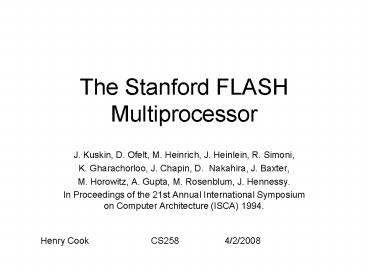The Stanford FLASH Multiprocessor - PowerPoint PPT Presentation
1 / 14
Title:
The Stanford FLASH Multiprocessor
Description:
The Stanford FLASH Multiprocessor J. Kuskin, D. Ofelt, M. Heinrich, J. Heinlein, R. Simoni, K. Gharachorloo, J. Chapin, D. Nakahira, J. Baxter, – PowerPoint PPT presentation
Number of Views:44
Avg rating:3.0/5.0
Title: The Stanford FLASH Multiprocessor
1
The Stanford FLASH Multiprocessor
- J. Kuskin, D. Ofelt, M. Heinrich, J. Heinlein, R.
Simoni, - K. Gharachorloo, J. Chapin, D. Nakahira, J.
Baxter, - M. Horowitz, A. Gupta, M. Rosenblum, J. Hennessy.
- In Proceedings of the 21st Annual International
Symposium on Computer Architecture (ISCA) 1994.
Henry Cook CS258 4/2/2008
2
Goals
- Support both cache-coherent shared memory and
message passing - Not just either/or, but both at the same time
- Design a custom node controller
- Build actual hardware
- 256 node target, scaling to thousands
- (Actually built 64)
3
Big Idea
- Principal difference between CCSM and MP is
protocol for transferring data - Overall machine structure is the same
- Functions performed by node controller are also
the same - By making the controller a special purpose
protocol processor, can leverage flexibility of
software while reducing overheads
4
System Architecture
- Each processor is a single MIPS chip
- MAGIC has a protocol processor
- Different messages types are processed by
different software handlers
5
Protocols - CCSM
- Directory-based, with dynamic pointer allocation
structure - Similar to DASH protocol
- Separate request-reply networks to eliminate
cycles - Handlers must yield if they cannot run to
completion
6
Protocols - MP
- Long messages vs short messages
- Block transfer vs synchronization
- User-level parameters passed to transfer handler
running on MAGIC - When all user message components have arrived at
dest., a reception handler is invoked
7
Protocols - Extensions
- Just have to change the handlers
- Emulate COMA attraction memories
- Implement synchronization primitives as MAGIC
handlers - Short message support similar to active messages
- Not user-level active messages
8
MAGIC Architecture
- Separation and specialization
- Use hardwired data movement logic for speed
- Use control logic that runs software protocols
for flexibility
9
MAGIC Architecture
- Must operate quickly enough to avoid being the
bottleneck - Hardware based speculative message dispatch to PP
- Separate hardware for message sends
10
Protocol Processor
- Implements subset of DLX ISA with extensions for
common protocol ops - Statically-scheduled dual-issue superscalar
processor - No interrupts, exceptions, address translation or
interlocks
11
Performance
- How do latencies look for local read misses?
- Derived from Verilog model
- Assuming PP cache hits
12
Performance
- PP occupancies are longest sub-operation that
must be performed - Block transfer bandwidth of 300-400MB/s
13
Testbed
- System-level simulator in C
- Protocol verifier, SPLASH benchmarks
- Verilog description of MAGIC
- N-1 simulated nodes and one Verilog node
14
Retrospective
- Flexibility of software handlers is key
- Supporting multiple protocols
- Scaling to arch to multiple machine sizes
- Debugging protocol operation
- Building hardware in an academic environment is
difficult and time consuming

